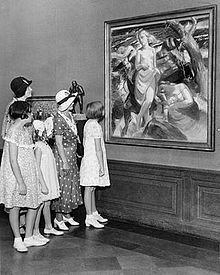When Walter Winans received his gold medal in the Olympic Games in Stockholm during the year 1912 his modality was not sports, he won the competition of sculpture with the creation of a half-meter bronze horse, surely you never thought that art formed part of the Olympic Games.

source: wikipedia
Believe it or not, during the first forty years of the Olympic Games, official medals were awarded to painting, sculpture, architecture, literature and music, along with the rest of the sports competitions.
Baron Pierre de Coubertin, founder of the Olympic Games, was convinced that artistic competitions were an integral part of the games, they were incomplete if they did not include some aspect of the arts.
At the beginning of the century, Coubertin could not convince the local organizers of the first Olympic Games (Athens, St. Louis and Paris) that artistic competitions were necessary, but in 1912 he managed to convince them, however it was specified that the main theme of these arts should be related to sport. The truth is that the format of the competitions was very confusing and the judges were not internationally renowned, so a category could get a silver medal without anyone winning the gold, or directly the jury could be so disappointed in the presentations that I decided not to award the highest award.

source: emol.com
Finally, in the 1948 Olympic Games it was decided that the art competitions would no longer be part of them and were replaced by exhibitions.
Things in the story ...!
Cuando Walter Winans recibio su medalla de oro en los Juegos Olimpicos de Estocolmo durante el año 1912 su modalidad no era deportiva, el gano la competición de escultura con la creación de un caballo de bronce de medio metro, seguro que nunca pensaste que el arte formaba parte de los Juegos Olímpicos.
Aunque no lo crean durante los primeros cuarenta años de los Juegos Olímpicos se otorgaron medallas oficiales a la pintura, la escultura, la arquitectura, la literatura y la música, junto con el resto de las competiciones deportivas.
El Barón Pierre de Coubertin, fundador de los Juegos Olimpicos, estaba convencido de que las competencias artísticas eran parte integral de los juegos, los mismos estaban incompletos si no incluía algún aspecto de las artes.
A principios de siglo, Coubertin no pudo convencer a los organizadores locales de los primeros Juegos Olimpicos (Atenas, San Luis y París) de que las competiciones artísticas eran necesarias, pero en 1912 los llego a convencer, sin embargo se especifico que el tema principal de estas artes deberían estar relacionadas con el deporte. Lo cierto es que el formato de las competiciones era muy confuso y los jueces no eran de renombre internacional, así que una categoría podía obtener una medalla de plata sin que nadie ganara el oro, o directamente el jurado podría estar tan decepcionado en las presentaciones que decidía no otorgar el máximo galardón.
Finalmente, en los Juegos Olímpicos de 1948 se decidió que las competiciones de arte ya no serian parte de los mismos y se reemplazaron por exhibiciones.
Cosas de la historia...!